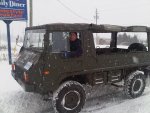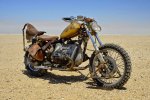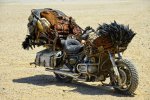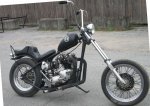Been done
The Last Chase
From Wikipedia, the free encyclopedia
Jump to navigationJump to search
The Last Chase is a 1981 Canadian-American
dystopian science fiction film directed by
Martyn Burke who was also the producer on the film, produced for Argosy Films. The film stars
Lee Majors,
Burgess Meredith and
Chris Makepeace in a futuristic scenario about a former racing driver who reassembles his old Porsche and drives to California in a world where cars and motor vehicles of all kinds have been outlawed by the powers that be.
[2]
Contents
Plot[edit]
In the year 2011, the United States is a
police state. A substantial percentage of the population was wiped out by a devastating viral
pandemic 20 years earlier. Amidst the resulting chaos and general panic, democracy collapsed and a totalitarian cabal seized power. After moving the seat of government to Boston, the new dictatorship outlawed ownership and use of all automobiles, boats and aircraft, on the pretext (later proven false) that an even bigger crisis, the exhaustion of fossil fuel supplies, was imminent. The loss of other personal freedoms followed, and surveillance cameras now monitor private citizens' every move.
In Boston, Franklyn Hart (
Lee Majors), a former race car driver who lost his family to the plague, is a spokesman for the mass transit system. Publicly, he deplores the selfishness of private vehicle ownership and exalts the virtues of public transportation; privately, he is barely able to contain his contempt for the oppressive, autocratic bureaucracy and the dismal party line that he is compelled to promote.
Years before, as private vehicles were being confiscated, Hart sequestered his race car – an orange
Porsche 917 CAN-AM roadster – in a secret compartment beneath his basement. Over the ensuing years he has gradually restored it to drivable condition, raiding long-abandoned junkyards in the dead of night for parts. His goal is to drive across the country to "Free California", an independent territory that has broken away from the rest of totalitarian America. Young electronics whiz Ring McCarthy (
Chris Makepeace) deduces Hart's plan, and Hart reluctantly agrees to bring him along on his perilous journey.
The ubiquitous surveillance system catches Hart vaulting a junkyard fence; Hart and McCarthy flee Boston in the roadster as police close in. Although gasoline has not been sold for 20 years, Hart has access to a virtually inexhaustible supply, the residual fuel remaining at the bottom of subterranean storage tanks in every abandoned gas station in the country. He uses a portable hand pump to refuel from these tanks as necessary.
News of the duo's daring adventure spreads across the country. The government, represented by a
Gestapo-like figure named Hawkins (
George Touliatos) watches with growing concern as the public takes notice and cheers Hart's defiance of authority. Calls for a return to personal autonomy and democracy are heard, for the first time in two decades. Hart must be stopped; but ground pursuit is impossible, as the electric golf carts used by the police are incapable of chasing down a race car.
Hawkins orders J.G. Williams (
Burgess Meredith), a retired Air Force pilot, to track down and destroy Hart and his car in a Korean War-vintage
F-86 Sabre. He locates and strafes the car, wounding Hart. A community of armed rebels takes Hart and McCarthy in, hides the car, and treats Hart's wounds. A team of mercenaries soon locates and attacks the enclave, although Hart and McCarthy escape during the firefight.
Back on the open road, Williams once again has the roadster in his crosshairs; but now he is having second thoughts. As an old rebel himself, he is starting to identify with Hart's situation. Prodded by Hawkins, Williams initiates several more confrontations, but each time he backs off, to Hart's and McCarthy's bewilderment. McCarthy rigs a radio receiver and listens in on Williams's cockpit radio communications, then establishes a dialog with him using
Morse code via a hand-held spotlight. Eventually Williams confides that he is sympathetic to their cause.
But Hawkins is also monitoring Williams's radio communications, and after learning of his change of heart, orders the activation of a
Cold War-era laser cannon at a position ahead of Hart's route. Williams attempts to warn Hart, but his radio communications have been jammed. Williams releases his external fuel tanks ahead of the car, hoping the inferno will stop the car short of the cannon's range; but Hart, assuming Williams has changed allegiances yet again, drives on.
Williams strafes the laser, but cannot pierce its heavy armor; so he sacrifices himself in a kamikaze-style attack, destroying his jet and the laser installation. His sacrifice allows Hart and McCarthy to drive on toward California where they are welcomed as heroes.
Cast[edit]
How many local landmarks can you spot?























